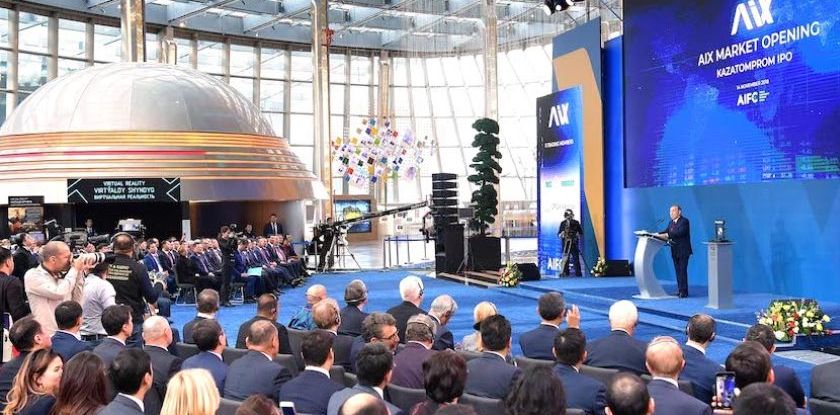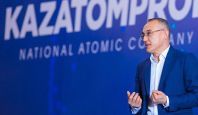Kazakhstan’s uranium producer Kazatomprom NC’s IPO held at the London Stock Exchange has elicited several important secrets of the company that, not too long ago, was still owned by the state. First and foremost, these secrets have to do with the company’s strategy and mission.
Note that, despite the fact just a small portfolio has been sold to the minority shareholders, they, in accordance with certain rules, receive a greater range of powers. Thus, de-jure, the company’s IPO means its corporatization and, de-facto, its privatization.
The former will lead to the serious changes in the decision-making process in the company and, therefore, in Kazakhstan’s uranium industry as a whole. The latter will dramatically strengthen the role of the private investors who have bought the shares of the uranium company.
Since most minority shareholders remain in the shadows hiding behind the façade of the investment funds, the “anonymity factor” is going to strengthen as well. In other words, the strategic suggestions in regard to the development of the national uranium industry will be voiced by the persons unknown to the broad audience and made by a narrow circle of those who are known but hidden from the public.
A strategy for the investors
Apart from the management structure, the company’s strategy is changing as well. When Kazatomprom was founded, it was supposed to grow into a “system integrator” of the future fully-functioning uranium complex. Now, it turns out, Kazatomprom, has decided to bank on becoming a regular resource-oriented company.
This is the way Kazatomprom’s development strategy has been defined for the investors. In the investment memorandum, it is stated that extraction and processing is the most attractive part of the nuclear fuel production. And this is exactly the area where Kazatomrom has the upper hand: the company extracts uranium via the in-situ recovery method. The use of this technology helps to ensure the sustainable profitability of the operations.
The document does talk about the possibility of entering the other spheres of the uranium business – conversion or operations with rare metals. But is also does state that such a scenario is optional.
Thus, the authors of the memorandum are selling the company to its future investors as the best-in-the-world uranium extractor. A resource-oriented corporation. And it is obvious that, having bought these prospects, the private investors would block any attempts to change the strategy. As for the possibilities for such blocking, the investors now have it.
The road map of Kazatomprom
Kazatomprom’s new strategy is not simply a promise to the investors but a true road map that the company has been following for five years now (although the official start to the restructuring was given in 2016). In the oblique language of the memorandum, getting rid of the “minor assets” is called “simplification of the operations”. As a result of this simplification, the company has disposed of 30 affiliated structures in the course of five years.
On the list of these companies, there is the MAEC (Mangistau Atomic Energy Combine). Launched in 1972, the fast neutrons reactor helped to create the nuclear distillation unit that, at that point, had no equal to it in the world. At the end of 1990s, in accordance with the international treaties, the reactor started to be taken out of service, the combine went bankrupt and, in 2003, was integrated into Kazatomprom NC. After that, they started negotiating a relaunch of the project. Today, these negotiations are history.
The plans to transform Kazatomprom into the second-largest world’s producer of beryllium and the fourth-largest producer of tantalum are now history as well. The authors of the prospect promise to continue implementing this strategy in 2019.
It is not quite clear how these plans correspond to the building of a TVA facility at the Ulba Metallurgical Plant (UMP) in Ust-Kamenogorsk. The UMP owns 51% of the facility; the remaining 49% are controlled by Chinese General Nuclear Power Corporation. Kazatomprom’s share in the UMP constitutes a little over 90%.
But the Ulba business is a special case. The plant will buy the Kazakh reactor fuel pellets for the Chinese nuclear stations for the duration of 18 years, from 2020 to 2038. The production line will be set on the basis of the French technology provided by Areva (Orano). By the logic of the memorandum, this company must be taken off Kazatompom’s balance and dissolve somewhere in the debris of the Chinese demand.
Raw stuff and trading
Before conducting the IPO, Kazatomprom had taken decisive action in regard to increasing its resource assets portfolio. Starting from January 1, 2018, the company has increased its share in Inkay, a joint venture with Canadian Cameco, from 40% to 60% and, by the start of 2019, its share in Bayken-U (joint venture with Japanese companies’ consortium Energy Asia) is to grow from 5.0% to 52.5%. Kazatomprom’s share in Khorasan-U, a joint venture with Rosatom and Marubeni Corporation, is to increase from 34% to 50%.
The emphasis the company lays on the organization of the trading operations also correlates to Kazatomprom’s new strategy. The authors of the memorandum promise to the investors that trading will become a systemic element of the company’s operations and will determine the work pace of its production facilities. For the record, subordinating uranium extraction to trading tasks has always been any cartel’s dream. But, rarely if ever, has this dream come true.
One way or another, Kazatomprom has founded its trading company in Swiss Zug that is considered the world’s Mecca for traders. It was created by the efforts of Marc Rich, the founder of the Glencore corporation. But, so far, the idea to launch real trading operations seems but a pious hope.
The authors of the memorandum acknowledge that the sale of the uranium at the world’s spot-market will only be an official channel for delivering it to the US nuclear stations that prefer (or have to) purchase resources in precisely this way
The uranium mirror
As we can see, the Kazakh uranium complex, despite its brilliant start at the beginning of the Millennium, is now repeating the fate of the other sectors of the country’s economy, in other words, is becoming a resource exporter.
There is, however, one important detail.
When analyzing the causes of the total commoditization of the post-Soviet economies (including that of Kazakhstan), the experts usually argue that the Soviet economic system only “damaged” the good raw materials producing the good-for-nothing products; therefore, the exporting of the resources was a rational strategy for the time. However, this theory has never been applicable to the uranium complex.
Former Head of Kazatomprom Mukhtar Dzhakishev who had propelled the company to the world’s frontline, had always spoken on the necessity of abandoning the export of raw uranium. Dzhakishev was put in prison and the company ended up in somebody else’s hands which, eventually, led to its commoditization. Not the other way around.
Therefore, it is the people, not the products, that matter after all. The resource-oriented economy is not based on the strife to be active. Moreover, it is better suited for distributing the rent along the storeys of the social pyramid whose support also requires the authoritarian system of governance. The irony is that this is exactly the kind of company that the Western investors desire. Perhaps this is the kind of country they desire as well?
The main resource companies affiliated with Kazatomprom
Company |
Share, % |
Status |
Resources, mln ton |
Partner |
ORTALYK |
100 |
Affiliated |
64,5 |
|
SEMIZBAY-U LLP |
100 |
Affiliated |
74 |
|
RU-6 LLP |
100 |
Affiliated |
20,9 |
|
APPAK LLP |
65 |
Affiliated |
54,8 | Sumitomo Corporation and Kansai Electric Power, |
Inkay JV |
60 |
Affiliated |
264,8 |
Cameco |
Budenovskoye JV LLP |
51 |
JV |
|
Stepnogorsk Mining Chemical Combine LLP |
SEMIZBAY-U LLC |
51 |
JV |
60,1 | Beijing Sino-Kaz Uranium Resources Investment Company Limited |
Akbastau JSC |
50 |
JV |
49,6 |
Uranium One Amsterdam B.V.» |
Karatau LLP |
50 |
JV |
59,3 |
Uranium One Netherlands B.V.» |
KATKO JV |
49 |
Associated |
57,6 |
Areva (ORANO) |
Khorasan-U JV |
33,98 |
Associated |
40 |
Uranium One Utrecht B.V — 30%, Energy Asia Holdings) — 36,02% |
Southern Mining Chemical Company LLC |
30 |
Associated |
110,8 |
Uranium One 70% |
Zarechnoye |
49,98 |
Associated |
8 |
Uranium One and Karabaltinsky Mining Combine JSC |
Kyzylkum LLP |
30 |
Associated | Energy Asia (B.V.I.) Limited, UrAsia London Limited. | |
Bayken-U LLP |
5 |
Associated |
20 |
Energy Asia Limited (95%) |






